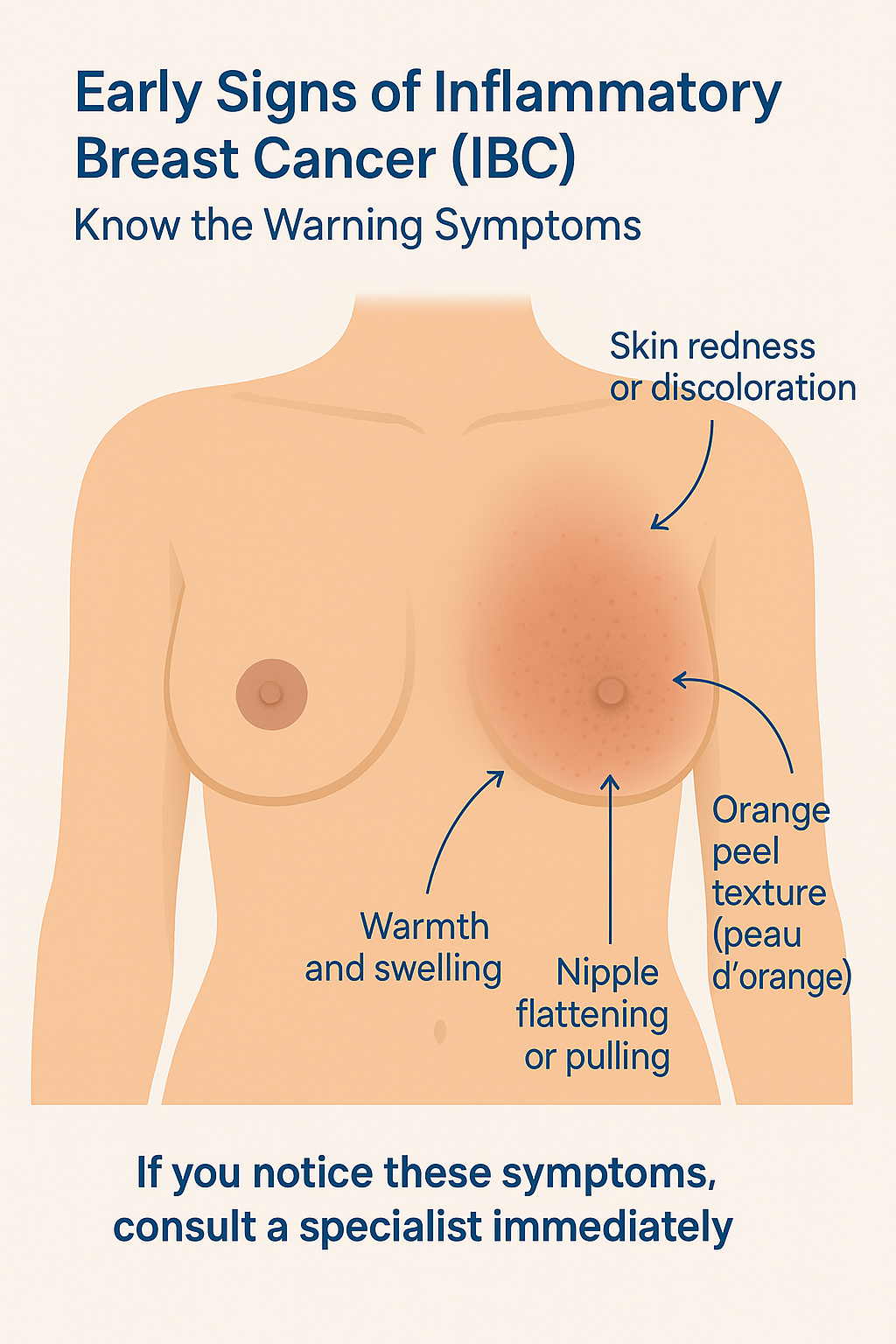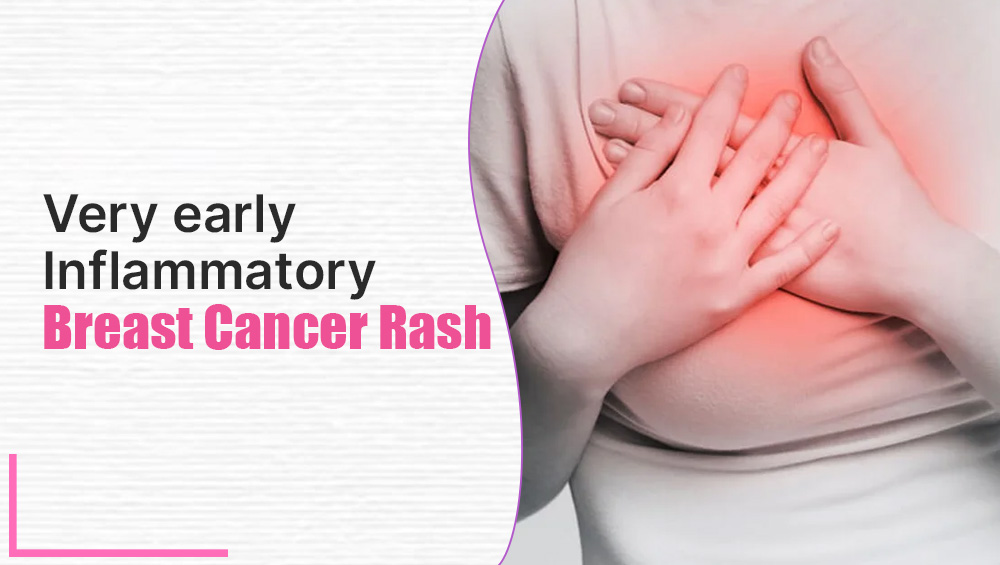The very early rash of inflammatory breast cancer (IBC) is not really early. It's an aggressive form of breast carcinoma that can develop rapidly. It is often marked by redness, swelling and an orange-peel texture across a third or more of the breast in a matter of weeks.
The cause of this rash, which is not an infection, is cancer cells that block the lymphatic vessels. The symptoms can develop rapidly and include breast tenderness, weight gain, or a feeling of burning. If you notice any of these changes, it is important to consult a physician immediately. They can mimic a breast condition.
In this blog, we’ll take a closer look at what’s often called the “very early inflammatory breast cancer rash” and why it’s important not to ignore it.
What Does the Very Early Inflammatory Breast Cancer Rash Look Like?
It is difficult to tell, as not everyone's rash looks the same; rashes can also appear very differently in different individuals. It does not always look like a rash. Sometimes, the skin on the breast may show enlarged pores due to swelling. There may also be signs like redness or other visible color changes.
The rash linked to inflammatory breast cancer may show up differently depending on a person's skin tone. In some women, it may appear darker or even have a purplish hue. There is no universal skin change that affects all women. No matter how early it may be suspected that a rash could be an inflammatory breast cancer, the rash will be considered at least stage III.
You might also see:
-
Slight swelling
-
Itching
-
A bruise-like mark that doesn’t fade
-
Skin that looks irritated, but doesn’t get better with cream

What characteristics distinguish an inflammatory breast cancer rash from other kinds?
Changes in speed are one aspect of the picture. The speed of cancer spreading in fatal cases can be astonishing. It is important to consult a doctor if you notice a change in texture, size, color or other characteristics of a breast within a few days, and even hours, in some cases.
In some cases, a small bug bite or rash can be the beginning of a rash. However, for the majority of women this rash will quickly spread to the breasts. A rash that grows is something you should not ignore.
Signs and Symptoms of Inflammatory Breast Cancer
The IBC does not cause breast lumps in the same manner as other breast cancers or benign breast disorders. However, the IBC does cause the following symptoms, which appear very quickly and do not go away. Here are the warning signs of breast cancer rash.

- Dimpling the breast skin
- Nipple flattening or pulling
- Orange peel texture (peau d'orange)
- A bruise or rash that covers one-third of the breast and other symptoms
- An enlarged breast such that one breast is larger than the other
- An inverted or retracted nipple
- Mastalgia and or breast swelling, which may cause breast skin to itch and become firmer
- Discoloration of skin, which may present pink, red, and or purple depending on the person’s complexion
- Swollen and or sore lymph nodes under the arm or above the collarbone
- Having the breast become warm or have a burning sensation
Causes & Risk Factors of Inflammatory Breast Cancer
The exact cause of IBC is not fully understood, but research highlights several risk factors of inflammatory breast cancer rash:
- Obesity (BMI ≥ 30)
- Dense breast tissue
- Younger women (sometimes before age 40)
- Family history or genetic mutations (BRCA1/BRCA2)
What Should You Do If You See a Rash?
First, don’t panic. Not every breast rash is cancer.
But if it’s not going away, or getting worse, or the skin feels heavy or warm, come get it looked at. Even if your doctor says, “It’s probably nothing,” ask for a second look. Ask for an ultrasound. Ask for a biopsy if needed.
It’s your body. You’re allowed to ask. You should ask.
Can We Catch IBC Early?
Yes. But you have to notice skin changes early. That’s the only window we get.
Because IBC spreads fast, there isn’t a long waiting period like with other breast cancers. You don’t have months.
You need to act when it’s still at the skin level—before it goes deeper, or spreads to lymph nodes.
FAQs for Inflammatory Breast Cancer
1. What is a Stage 1 breast cancer rash?
Ans - A Stage 1 breast cancer rash may look like persistent redness, irritation, or small patches of discolored skin on the breast. In inflammatory breast cancer, this rash can spread quickly and is often mistaken for mastitis or an allergic reaction. The skin may appear tight, dimpled, or itchy. Since IBC progresses faster than other breast cancers, any rash that doesn’t heal within 7–10 days should be checked by a breast cancer specialist.
2. What does stage 1 inflammatory breast cancer look like?
Ans - Stage 1 inflammatory breast cancer (IBC) is extremely rare because IBC is usually diagnosed at a more advanced stage. In its early phase, IBC may appear as an enlarged breast with thickened skin or changes in the color of the breast, such as red, purple, or bruised. Unlike a typical lump, IBC often causes the breast to feel warm, heavy, or tender with skin changes that resemble an orange peel (peau d’orange). If such symptoms don’t improve with antibiotics within a week, further testing should be done immediately.
3. What were your first symptoms of inflammatory breast cancer?
Ans - First symptoms of an inflammatory breast cancer is include redness, swelling, skin changes like thickening, warmth, infection or rash, tenderness, or burning.
4. What kind of breast cancer starts with a rash?
Ans - In most cases, rash-like skin changes such as redness, swelling and warmth serve as the first signs of inflammatory breast cancer as the condition does not begin with a lump. Another rare condition, Paget's breast disease, begins with the same skin changes but additionally skin irritation or rash around the nipple and areola.
5. How to identify a cancerous rash?
Ans - A medical professional will conduct a physical exam followed by X-rays or biopsies as these tests are the only way to identify a cancerous cells and it is important to consult a doctor if you notice any changes in your skin.
6. Does a breast cancer rash appear suddenly?
Ans - Yes, rashes from inflammatory breast cancer may appear very quickly and sometimes within a few days as the rapid onset of IBC is one way to distinguish it from other breast conditions that develop more slowly.
Conclusion
Inflammatory Breast Cancer is rare, but aggressive. Even little changes, such as swelling, redness or a persistent rash, deserve attention. IBC is not for every rash. Don't hesitate to act if something doesn't feel right. You should consult a medical oncologist or Cancer specialist. Ask for a scan. If needed, insist on a biopsy. Early detection makes a big difference in Cancer.
If you need expert guidance or have any concerns, Contact Dr. Pooja Babbar the best medical oncologist Gurgaon has to offer. She has over 15 years of experience in cancer treatment.














